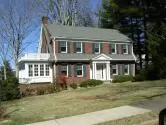Have We Become a Tradition?

It was an uneventful Sunday night after an uneventful week, which sometimes is just what we need, right
And so I picked up the latest issue of a glossy regional magazine, intrigued by a cover story which read “Bold Re-Do for a Grove Park Home.”
St. Louis pharmaceutical magnate and real estate mogul Edwin Wiley Grove (1850-1927) had established a second home in Asheville by 1900, when he began buying what eventually amounted to nearly 1200 acres of land bordering the north side of the city. After the devastating recession of 1908-1909, Grove hit upon the idea of building a luxury hotel on Sunset Mountain overlooking the city, calculating that if he could attract the rich and famous to his hotel, they would experience the charms of Asheville and the serenity of the Blue Ridge Mountains, and purchase Grove’s nearby lots upon which to build their homes.
Completed on July 12, 1913, the Grove Park Inn succeeded in meeting Grove’s expectations, due largely to the management style of his son-in-law Frederick Loring Seely, who was a friend and client of Elbert Hubbard and the Roycrofters. It was Fred Seely, in fact, who convinced E. W. Grove that the Grove Park Inn should be built and furnished in the Arts and Crafts style.
The neighborhoods surrounding the Grove Park Inn featured an abundance of homes designed, built, furnished, and influenced by the Arts and Crafts style. These homes never really went out of favor, always remaining one of the most popular neighborhoods in the city, even through the decades of the depression, the war years, and the rise of mid-century modern.

Once the Arts and Crafts revival took root in the 1970s, the stately homes and modest bungalows in the Grove Park Historic District dramatically increased in popularity and value, and remain in high demand today. And so I casually flipped through the magazine, fully expecting to see a restored early 20th-century era interior tastefully and historically furnished with a mixture of vintage and antique style furnishings matching the era of the house. You can imagine my surprise, then, when I read about the owners:
“They loved the neighborhood, the street, and the chance to break away from the prevailing Arts and Crafts tradition.”
Now, instead of warm, soothing earth tone plaster walls, natural woodwork, and furniture of the era, the 1920s house is lined with modern jarring and jagged striped wallpapers, its original charm and character smothered under an assortment of vinyl, glass, and chrome mid-century modern reproductions.
“Break away from the prevailing Arts and Crafts tradition . . . .”
Is this a glimpse into what the future holds?
Has Arts and Crafts become so mainstream that it is now a “tradition” to be broken?
Suddenly it feels like 1955 all over again . . . .

Until next Monday,
The first step in renovation is education.
BruceTop: The 1913 Grove Park Inn, site of the 30th National Arts and Crafts Conference in February.
Middle: A typical Grove Park neighborhood home (not the one in the story).
